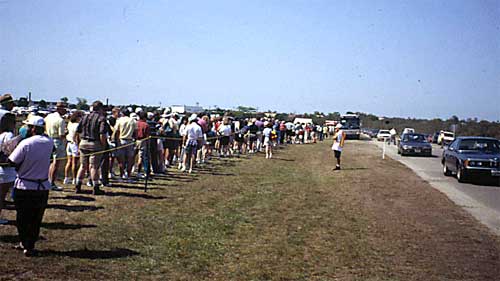
Managing Travel for Planned Special Events
Chapter Three. Overview
Page 1 of 8

Figure 3-1. Event Pedestrian Management
Purpose 
This chapter presents a high-level summary of managing travel for planned special events for all users of this technical reference. It aims to identify the key aspects of each step necessary to manage travel for a specific planned special event and all special events in a region.
This chapter provides a background on the purpose of managing travel for planned special events. It highlights all of the steps necessary to manage travel for a particular planned special event and all planned special events in a region. Recommended policies, guidelines, procedures, strategies, and resource applications that support and facilitate each step are indicated and organized through the following five phases: program planning, event operations planning, implementation activities, day-of-event activities, and post-event activities.
Introduction 
This chapter provides all users with a working knowledge of the techniques and strategies that practitioners may use to successfully: (1) plan for and operate a particular planned special event or (2) manage all planned special events in a region. In turn, individual stakeholders gain an understanding of the collective tasks facing multidisciplinary and inter-jurisdictional planned special event stakeholder groups charged with developing and implementing solutions to acute and system-wide impacts on travel during a special event.
Subsequent chapters of this handbook provide expanded and in-depth coverage of all potential tasks and stakeholder activities conducted within individual planned special event management phases. Chapters 4 through 10, which represent the core chapters of this handbook, contain detailed information on advance planning, day-of-event operation, and post-event evaluation activities that stakeholders perform and/or consider in mitigating special event impacts on transportation system operations. Chapters 11 through 15 describe an advance planning and travel management process and considerations specific to a particular category of planned special event.
A background section describes how transportation operations vary during a planned special event and identifies advance planning activities employed to successfully manage travel for a special event. This section identifies specific stakeholders, coupled with their typical duties and responsibilities, that may actively participate under different phases of special event management. It also includes a discussion on the distinct, chronological phases of managing travel for planned special events, including the common products generated in each phase and associated benefits of carrying out each phase.
A section on categories of planned special events identifies special characteristics specific to each event category that impacts transportation system operations.
This chapter concludes by summarizing planning approaches, operational strategies, and technology applications for managing transportation system operations during phases of managing travel for planned special events. These sections collectively present all the steps necessary to manage travel for a particular planned special event in addition to future events in a region.
Planned Special Events Traffic Management | Privacy Policy